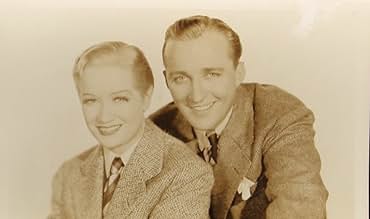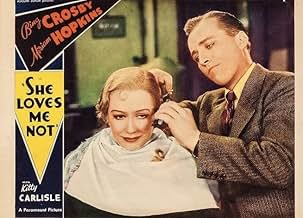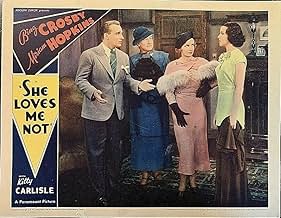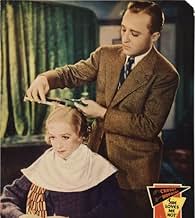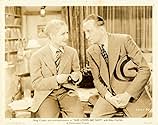Ajouter une intrigue dans votre langueA cabaret dancer witnesses a murder and is forced to hide from gangsters by disguising herself as a male Princeton student.A cabaret dancer witnesses a murder and is forced to hide from gangsters by disguising herself as a male Princeton student.A cabaret dancer witnesses a murder and is forced to hide from gangsters by disguising herself as a male Princeton student.
- Réalisation
- Scénario
- Casting principal
- Nommé pour 1 Oscar
- 1 victoire et 1 nomination au total
- Buzz Jones
- (as Edward Nugent)
- Martha - the Mercers' Maid
- (non crédité)
- Detective
- (non crédité)
- Lawton's Secretary
- (non crédité)
Avis à la une
The movie begins with the opening titles and credits over the view of a Princeton University in which off-screen students are heard singing "Three Cheers for All, That's All." Then while the credits are still imposed on the screen, the scene changes focus to a nightclub in Philadelphia where Curly Flagg (Miriam Hopkins) is singing and dancing to a jive number, "Put a Little Rhythm in Every Little Thing You Do." While she is doing her tap dance, gun shots are heard and a man falls dead, causing excitement and screaming among the patrons. Because Curly happens to be the closest one to witness it, and not wanting to get mixed up in a gangland killing, she sneaks away from the nightclub and heads straight to the nearby train station. With only 75 cents to her name, Curly uses it to buy a ticket going as far as Princeton University. After arriving at the university, Curly, quite hungry, comes upon an open window where she finds Paul Lawton (Bing Crosby), a student who not only writes songs, but is studying to become a surgeon. Paul then encounters Curly, and with the help of his roommate, "Buzz" Jones (Edward J. Nugent), the two young men decide to help Curly by cutting her hair and dressing her up as one of the boys. Complications ensue in trying to keep Curly from giving herself away. Later, Lawton meets Midge Mercer (Kitty Carlisle), the dean's (Henry Stephenson) daughter, and becomes very much interested in her, in spite of he being engaged another girl, the snobbish Frances Arbuthnot (Judith Allen). The rest of the plot focuses on the gangsters who, after learning of Curly's whereabouts, coming to Princeton to try and kidnap her, and Lawton and Jones trying to prevent themselves from getting expelled shortly before graduation after the dean learns of what's happening.
SHE LOVES ME NOT was a highly successful comedy upon its release, but for now, comes somewhat forced, especially by Miriam Hopkins who is sometimes hilarious in her role, but then again her occasional screeching and screaming growing tiresome after a while. Aside from the usual college hi-jinx, the movie is presented with some nice tunes, mostly sung in good voice by Bing Crosby on the piano. In the supporting the cast are Lynne Overman, George Barbier, Ralf Harolde, Vince Barnett and Warren Hymer. Barnett and Hymer play gangster stooges hired by Harolde to kidnap Curly. Hymer's kidnapping methods comes off a bit strange here, for which he not only tries to get his victim unconscious by strapping a pillow over the girl's face, but for the men, forces them at gunpoint to drop their pants and leaving them in boxer shorts! Judith Allen, who was Crosby's featured co-star in TOO MUCH HARMONY (Paramount, 1933), appears in a secondary role as his fiancée as well as a kidnapping victim mistaken for Curly (Hopkins).
The songs composed for the movie include: "Put a Little Rhythm in Every Little Thing You Do" (by Mack Gordon and Harry Revel); "Cocktails for Two" (by Johnny Burke, Sam Coslow and Arthur Johnston, instrumental/ danced by Miriam Hopkins); "Straight From the Shoulder, Right From the Heart" (by Gordon and Revel); "Love in Bloom" (by Leo Robin and Ralph Rainger, both sung by Crosby and Kitty Carlisle); "I'm Humming, I'm Whistling, I'm Singing" (by Gordon and Revel, sung by Crosby); "Love in Bloom" (reprise); "Three Cheers for All, That's All," followed by other traditional college songs; and "I'm Humming, I'm Whistling, I'm Singing" (reprise by Crosby). Of all the melodies heard in this production, only "Love in Bloom" became a solid hit. So popular, it was nominated for an Academy Award for the initial Best Song category of 1934. While it did not win that honor, losing to "The Continental" from THE GAY Divorcée (RKO), it soon became comedian Jack Benny's lifelong theme song in both his radio and television shows. Plugged twice in the story by Crosby and Carlisle, the reprise comes off quite memorable as the couple converse on the telephone in a split screen view with a telephone pole between them as the two decide to sing their love song together.
SHE LOVES ME NOT was remade by Paramount in 1942 as TRUE TO THE ARMY starring Judy Canova, Allan Jones and Ann Miller, in the Hopkins, Crosby and Carlisle roles; and again by 20th Century-Fox in 1955 as HOW TO BE VERY, VERY POPULAR with Betty Grable, Robert Cummings and Sherre North. All three are seldom seen these days, but to watch and compare all three, start with the original. (***)
There are a lot of moving parts in this musical comedy directed by Elliot Nugent. Miss Hopkins is slightly miscast as a nitwit -- they wanted Marion Davies for the role -- but she does a mean tap. It's more frantic than funny, but it seems to have done very well at the box office.
In this picture, as in Here Is My Heart the same year, the studio (why?) gave him Kitty Carlisle, the ponderous actress who acts comedy by making like a middle-aged good sport who's being good-naturedly informal with the kids. Even the number Bing adopted for his theme song, "Love in Bloom," doesn't whip up a romantic mood, even when Bing and Kitty, weirdly, sing it as two disembodied heads in a cloudy sky. But a youthful is rather foreclosed by a star who, more than ten years too old for his role, looks like a college professor rather than the undergrad he is supposed to be.
Kitty is further minimised by being sited outside the main plot, one that might have been the inspiration for Some Like It Hot. Miriam Hopkins, as a nightclub dancer (and can she shake a leg! who knew?), witnesses a gangland rubout and, fleeing the gangsters who want to do away with her, ends up at Princeton, where Bing helpfully cuts off her hair and gives her boys' clothes to hide in. Miriam turns out to be the most ungrateful damsel in distress ever rescued, constantly lying, mischief-making, and rather undermining the idea of hiding out by becoming a glutton for publicity. But her antics, rather than pepping up the show, fade away in this staid atmosphere.
Thirties character comedians Warren Hymer and Lynne Overman have some funny business, but the pace sags and the dialogue lacks invention. Fortunately, though, Bing ends up with Kitty without having to kiss her. How he must have been relieved!
She Loves Me Not isn't the cutest movie in the world, and it wasn't half as cute as I thought it was going to be. It's always fun to see Miriam Hopkins early in her career, prancing around in her underwear, but most of the plot and gags rely on the audience being too stunned by her near-nudity to pay attention to anything else. For example, she sits Bing Crosby down and gives him a 1934 version of a lap dance, and all he does is scold her and run out of the room. The screenwriters could have given him so many funny jokes during that scene!
Also, Miriam's character is very clearly written to be a nightclub floozie who has no shot at getting the guy. Bing serenades Kitty Carlisle with "Love in Bloom" and never really looks twice at Miriam; therefore, there's no tension in the plot. So, unless you want to see Miriam Hopkins in her underwear, you don't have to watch this one. There are plenty of other movies where you can catch her in her skivvies, or less.
Le saviez-vous
- AnecdotesWhile filming this picture, the spirit gum holding Bing Crosby's ears back failed; he insisted on completing the film with his ears out, and never used the gum again.
- Citations
Curly Flagg: Can I play the part? What's it like?
Gus McNeal: Well, you're dancing in a nightclub. A gangster comes after you. Somebody like, er, George Raft.
Curly Flagg: Swell!
Gus McNeal: He tries to make love to you but you fight him off.
Curly Flagg: Comedy, huh?
Gus McNeal: Oh, no, no, no. This is serious. You are a pure, sweet girl.
Curly Flagg: Yeah?
Gus McNeal: Yeah. But some instinct tells you what he wants so you fight him off. He tears part of your clothes off. And you stand there before him half-clothed.
Curly Flagg: Swell!
Gus McNeal: Now then, your brother comes in just in time and shoots him. You run away so you won't have to appear as a witness against your brother and a college boy finds you and hides you.
Curly Flagg: Say, that's a co-incidence.
Gus McNeal: Yeah, isn't it? Well, you and the boy fall in love with each other. But his father, a fanatic, accuses you of being a bad girl. You convince the father that you are pure so he tries to get you. He tears your clothes off.
Curly Flagg: Yay!
Gus McNeal: This time, the son rescues you. And marries you.
Curly Flagg: Then he tears my clothes off?
Gus McNeal: That is an idea.
- ConnexionsReferenced in Le gosse aux millions (1934)
- Bandes originalesPut a Little Rhythm in Every Little Thing You Do
(uncredited)
Music by Harry Revel
Lyrics by Mack Gordon
Sung and danced by Miriam Hopkins
Meilleurs choix
Détails
- Date de sortie
- Pays d’origine
- Langue
- Aussi connu sous le nom de
- Hon älskar mig ej
- Lieux de tournage
- Société de production
- Voir plus de crédits d'entreprise sur IMDbPro
- Durée1 heure 25 minutes
- Couleur
- Rapport de forme
- 1.37 : 1
Contribuer à cette page



